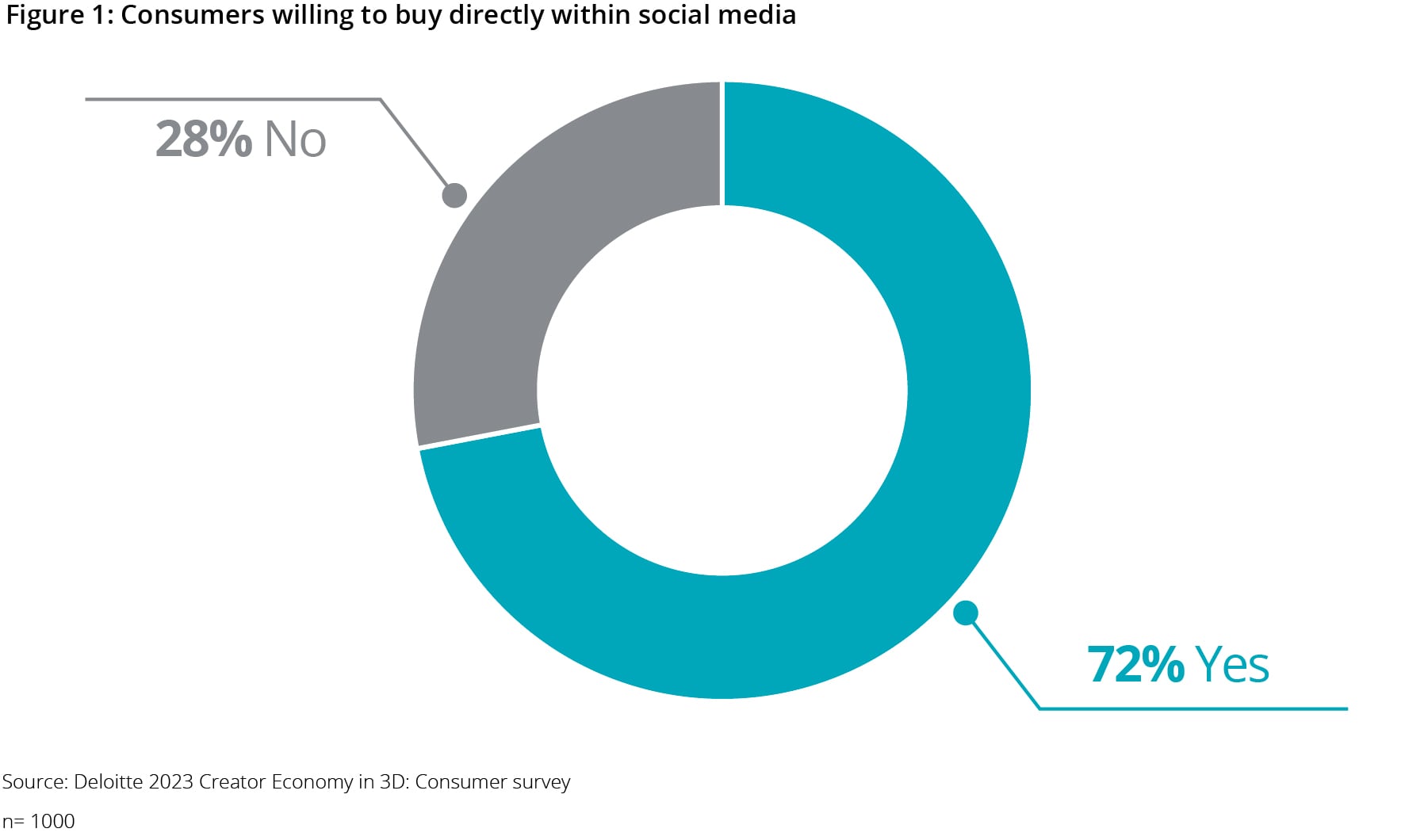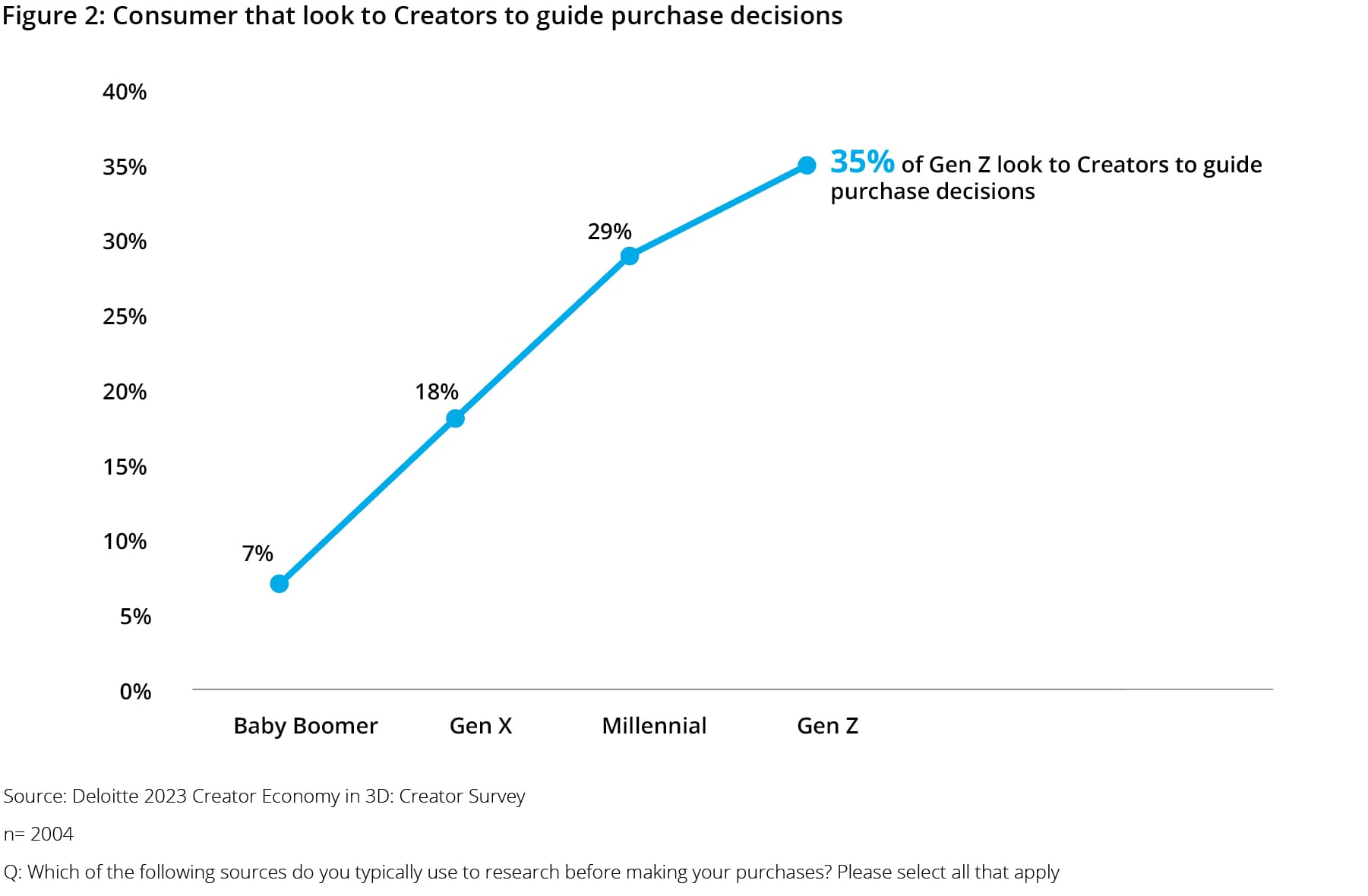Social Commerce and the Creator Economy has been saved

Perspectives
Social Commerce and the Creator Economy
How brands can engage creators to activate their social commerce strategy
Social Commerce blends eCommerce capabilities with social media and online marketing channels to provide a shopping experience that intends to meet customers where they are, without having to leave the social platform. Content creators are a key pillar of a social commerce strategy, generally providing a direct line to a more captive audience, and the ability to engage consumers within a more authentic and relatable context than a traditional brick-and-mortar or owned platform eCommerce experience. This report explores the cornerstones of an effective social commerce strategy- and how creators can drive the customer journey and purchasing behaviors.
Consumers increasingly look to social media for their shopping experience
Deloitte’s new State of Social research finds consumers are increasingly willing to buy products and services—even from brands they didn’t previously know—directly through social platforms. In fact, 72% are now willing to buy directly within social media platforms and 60% of consumers responded that they want more opportunities to discover and purchase products on social media.i

An effective social commerce strategy addresses three key areas
In looking at how brands approach the creator economy and social commerce, we found certain brands stood out from the rest. Socially mature brands, what we call “social-first” brands, differentiate themselves by building commerce objectives and creator-led strategies into their overarching social strategies. In our State of Social report, we found these social-first brands achieved an average revenue increase of 10.2% as a direct result of social strategies—and are 8 times as likely to have exceeded revenue goals by 25% or more in B2C lines of business.
To help strategically reach consumers where they are, there are three key areas that help enable social commerce and, when successfully leveraged, drive purchase: Content, Community, and Experience.
Content: Content is the lifeblood of social media platforms —the unique and meaningful content created by brands or creators that drives action. Brands engaging in social commerce should maintain cohesive brand positioning and messaging for consumers on the front end. Leveraging creator-produced content means finding the appropriate balance between allowing creators to convey the brand message through their own creative lens, while maintaining this cohesion.
Community: Tapping into communities and existing networks can enable deeper and more targeted market penetration. Use social communities to help make sure your brand is tapping into the appropriate communities you want to reach—but you should also understand which communities your creator partners resonate with, and if there’s an audience-product fit.
Experience: Creating a seamless customer experience is a key to a successful social commerce strategy. Brands should take into account the platform’s features and how these integrate into a customer shopping journey from discovery to purchase—ideally conducted without the consumer having to leave the platform. Potential strategies could include livestreaming, videochat in 1-to-1 conversations, augmented reality, or virtual shopping.
Content creators play an increasingly pivotal role in guiding purchase
Social-first brands are 3.5x as likely to say boosting SEO is extremely important to their social strategiesii, but there has been a generational shift in consumer purchasing behavior away from traditional web search engines. Younger, digitally native, generations now tend to engage in product discovery and research directly on social platforms—and creators have become drivers and go-to resources for consumers looking to make purchases on social media channels.
Deloitte’s 2023 Creator Economy in 3D research found that 35% of Gen Z consumers look to content creators to guide their purchase decisions. This figure is significantly higher than older generations (compared to Gen X at 18% and Baby Boomers at 7%) who tend to lean into web search engines and online retailers/stores as their top two avenues to help inform purchases online (see Figure 2).

Creator endorsements of brands are driving more traffic to brand’s websites and likely increasing brand awareness. As a matter of fact, in our 2023 Creator Economy in 3D study, 47% of respondents said that when engaging with a creator endorsement of a brand, they will take action by visiting the brand’s website.
Creators can drive engagement through the entire marketing funnel
While creators can help consumers with brand awareness and discovery, Deloitte’s 2023 Creator Economy in 3D study found that creators can have a powerful impact on certain consumers across the entire marketing funnel. Three out of five of creators’ most engaged followers—i.e. followers that actively seek out new content and updates from those creators— reported they are more likely to have a more positive attitude toward that brand, purchase that product, exploring their other products, and recommending that brand to others.
Whether through boosting discoverability, guiding customers toward your website, or driving purchase behavior, creators are poised to be an integral part of any social commerce strategy. A successful social commerce strategy tends to rely on bringing together several elements: content that is inclusive of creator content, connecting with communities, a connected consumer experience, and bringing your brand’s own internal teams together to achieve this.
Recommendations
GenAI and the Creator Economy: How creators are looking to leverage AI and what this means for brands
Content Creators and GenAI
Creator Economy in 3D: The platform’s place in a shifting media landscape
Consumers and social media




